Cancrinite
Feldspathoid mineral From Wikipedia, the free encyclopedia
Cancrinite is a complex carbonate and silicate of sodium, calcium and aluminium with the formula Na6Ca2[(CO3)2|Al6Si6O24]·2H2O. It is classed as a member of the feldspathoid group of minerals; the alkali feldspars that are poor in silica. Yellow, orange, pink, white or even blue, it has a vitreous or pearly luster; a hardness of 5–6 and an uneven conchoidal fracture. It is unusual among the silicate minerals in that it will effervesce with hydrochloric acid due to the associated carbonate ions.
| Cancrinite | |
|---|---|
 Cancrinite | |
| General | |
| Category | Tectosilicate minerals, feldspathoid group, cancrinite group |
| Formula | Na6Ca2[(CO3)2|Al6Si6O24]·2H2O |
| IMA symbol | Ccn[1] |
| Strunz classification | 9.FB.05 |
| Crystal system | Hexagonal |
| Crystal class | Pyramidal (6) (same H-M symbol) |
| Space group | P63 |
| Unit cell | a = 12.67(9) Å, c = 5.15(4) Å; Z= 1 |
| Identification | |
| Color | Grey-green, white, yellow, blue, orange, reddish |
| Crystal habit | Rare as prismatic crystals; typically massive |
| Twinning | Rare – lamellar |
| Cleavage | Perfect on {1010}, poor on {0001} |
| Fracture | Irregular/uneven |
| Tenacity | Brittle |
| Mohs scale hardness | 5–6 |
| Luster | Vitreous, greasy, pearly |
| Streak | White |
| Diaphaneity | Transparent, translucent |
| Specific gravity | 2.42 – 2.51 |
| Optical properties | Uniaxial (+/−) |
| Refractive index | nω = 1.507 – 1.528 nε = 1.495 – 1.503 |
| Birefringence | δ = 0.012 – 0.025 |
| References | [2][3][4] |
Found originally in 1839 in the Ural Mountains, it is named after Georg von Cancrin, a Russian minister of finance.[2]
References
Wikiwand - on
Seamless Wikipedia browsing. On steroids.
